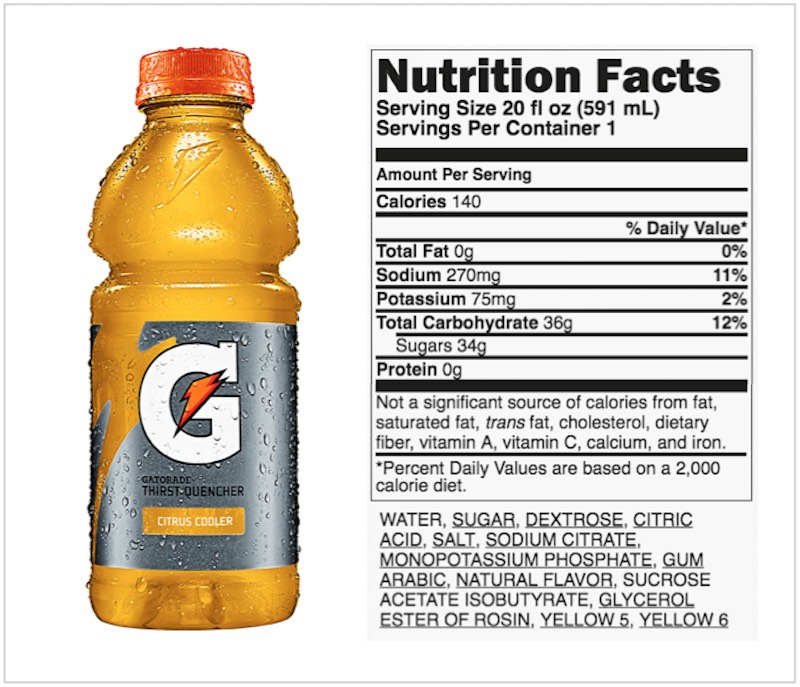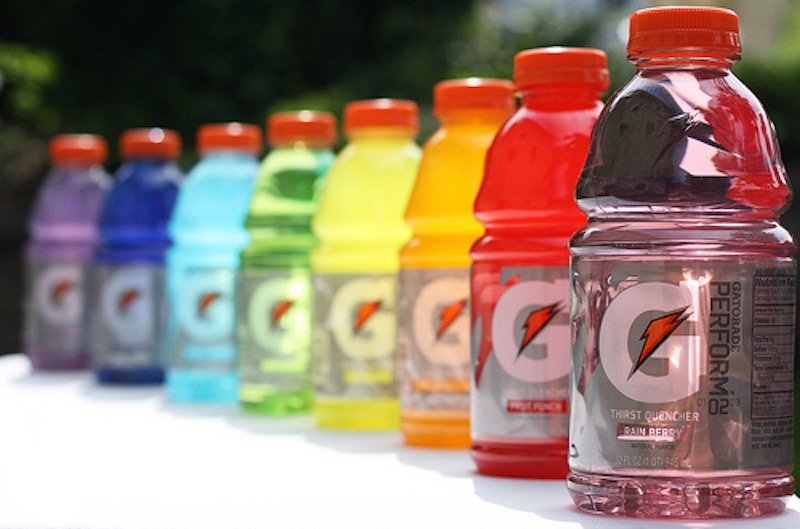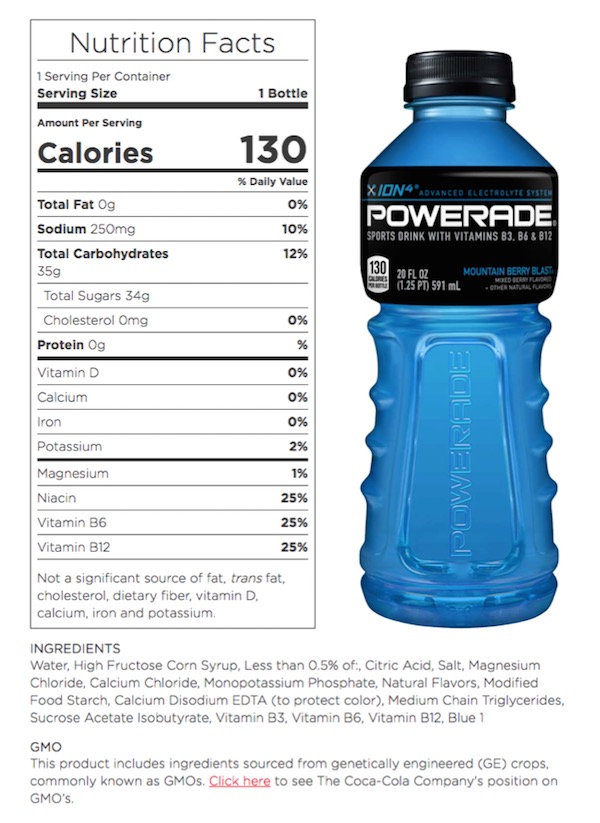Are Sports Drinks A Good Option For Rehydrating And Replenishing Your Electrolytes?
Last updated on
There’s a special kind of danger in products that seem healthy (or are marketed as such) but have nothing good, nothing natural, nothing even remotely healthy in them.
In this article, we’re going to take a close look at one of such hidden threats for your wellbeing: sports drinks.
Manufacturers affirm that their main purpose is to quench thirst and replenish electrolytes lost via sweating but is that true? Do they really help? If so, at what cost?
Let’s take a good look at the two most popular options and reveal their true faces.
Gatorade by PepsiCo
Let’s take a look at Gatorade Thirst Quencher Citrus Cooler, for example. Here’s what it contains, according to the manufacturer—in one 591 ml bottle (approx. 20 fl oz):

Ingredients: Water, sugar, dextrose, citric acid, salt, sodium citrate, monopotassium phosphate, gum arabic, natural flavor, sucrose acetate isobutyrate, glycerol ester of rosin, colorants (yellow 5 and yellow 6).
- Sodium – 270 mg
- Potassium – 75 mg
- Sugars – 34 g
Now let’s talk about why that’s BAD.
Reason 1: Sugar
It’s not news that added sugar is terrible for you. Check out our recent article for an overview of the 144 ways sugar can destroy your health.
But, how much is too much?
Well, according to the American Heart Association (AHA), the upper limit on the daily intake of sugar is:
- 150 calories for men (that’s about 36 grams, roughly 9 teaspoons)
- 100 calories for women (20 grams, roughly 6 teaspoons)
A bottle of Gatorade has 34 grams of sugar, which is just a bit under the recommended maximum for men and way over the top of the limit for women. And this is just only one drink.
As if that wasn’t enough, sugar actually increases thirst. Here’s why …
When the sugar from your food and drinks reaches your blood, the water from your cells moves into your bloodstream to dilute the blood and make it less sweet. That’s why you feel thirsty: your body wants you to drink more water to compensate the water that your cells lost to dilute your blood sugar.
Actually, that’s why people with poorly controlled diabetes feel thirsty much more often than healthy people: they have much more sugar in their blood, so the water from their cells constantly moves out of them to dilute their blood sugar levels. The result is obvious: frequent and significant thirst.
Reason 2: Bad Water-Electrolytes Balance
Have you ever thought about the amount of salts you lose with sweat?
Although the salt composition of sweat varies slightly from one person to another, here are some average numbers:
- Sodium – 863 mcg/ml
- Potassium – 222 mcg/ml
- Calcium – 16 mcg/ml
- Magnesium – 1.3 mcg/ml
In other words, one 591 ml bottle of Gatorade Flow compensates about 320 ml of sweat (in terms of electrolytes).
Here’s the math:
- A bottle of Gatorade contains 270 mg of sodium, which equals 270 000 mcg of sodium, which would be about 312 ml of sweat (270 000 / 863 = 312).
- A bottle of Gatorade contains 75 mg of potassium, or 75 000 mcg, which would be about 337 ml of sweat (75 000 / 222 = 337).
The problem is that you can sweat up to 1.5 to 3 L per hour of exercise in hot environments, or about 800 ml at room temperature. That’s anywhere from 2.5 to 9 bottles of Gatorade to make up for the lost electrolytes PER HOUR; an amount that no one in their sane mind would drink.
Even if you pick the low-sugar version of Gatorade, you’ll still be taking in a huge amount of artificial colorants.
Moral of the story: A sports drink is a bad choice to replenish electrolytes and water, no matter how you look at it.

Reason 3: Artificial Food Colorants (Food Dyes)
Yellow #5. Yellow #6. These are some of the food dyes most often used in different Gatorade (and other) sports drinks. Although these food dyes are FD&C-approved, they are far from being actually healthy.
For example, according to the detailed report Food Dyes: A Rainbow of Risks created by the Center for Science in the Public Interest, here are a few points you should remember at all times:
- Yellow #5: may cause sometimes-severe hyperactivity and behavioral problems in children, possibly by promoting loss of zinc.
- Yellow #6: may cause adrenal tumors, and may be contaminated with cancer-causing chemicals. Occasionally causes severe hypersensitivity reactions.
Other flavors of the Gatorade sports drinks and other sports drinks in the market, contain colorants Blue #1 and Red #40.
- Blue #1: an unpublished study highlighted the possibility that this dye can cause kidney tumors in mice and inhibit the healthy development of nerve cells.
- Red #40: may accelerate the development of immune system tumors in mice, and may trigger hyperactivity in children.
Additionally, both food dyes listed above were linked to numerous allergic reactions. Taking into account that they have no nutritional value or health benefits whatsoever, there’s absolutely no reason to have them in your life.
Powerade by Coca-Cola
Take the Powerade Mountain Berry Blast flavor for example. Original version with sugar (per 1 bottle of 591 ml or 20 fl oz):

Ingredients: Water, high fructose corn syrup, citric acid, salt, magnesium chloride, calcium chloride, monopotassium phosphate, natural flavors, modified food starch, calcium disodium EDTA (to protect color), medium-chain triglycerides, sucrose acetate isobutyrate, (added) vitamin B3, vitamin B6, vitamin B12, Blue 1.
- Sodium – 250 mg
- Potassium – about 90 mg
- Sugars – 34 g
Now, since the content of sugar, electrolytes, and food dyes in Gatorade and Powerade are roughly the same, we’ll just skip these sections: both drinks share the first 3 reasons to NOT drink them.
Reason 4: GMOs
Yes, Powerade contains genetically modified organisms, and this fact is openly stated on the official website.
The matter of safety of genetically modified products still sparks a lot of debates worldwide, and there is no universal opinion on the matter.
One thing is sure, however: GMOs are the farthest from “natural” as it gets.
If you really want to be in charge of what you put into your body, opting for natural drinks for rehydration and electrolyte replenishment is the way to go. Even drinking pure filtered water will be a way better option.
And even if you go for the low-sugar option, the harmful GMOs will still be there.
Reason 5: High Fructose Corn Syrup
In this Powerade flavor example as above, you can see High Fructose Corn Syrup (HFCS) being one of the main ingredients.
If you see this ingredient on any label, you can be sure that the food is pure, processed junk. Responsible food manufacturers wouldn’t put this in food, and smart consumers shouldn’t consume these foods.
HFCS is the typical added sugar component of many processed foods and have potentially negative health consequences. Most of the high fructose content that enters into your liver and cannot be converted into fat, will ultimately end up messing your body’s metabolism works. The results will be insulin resistance, obesity, type 2 diabetes and high blood pressure.
Besides the huge load of fructose and sugar found in HCFS, it has also been found to contain other harmful chemicals, contaminants and even trace amounts of mercury!
Seeing that so many processed foods contain this harmful ingredient, and that Americans consume an average of 32 teaspoons of sugar every day, one can only imagine the accumulation of contaminants in the body that will eventually lead to some kind of diseases.
Are Sports Drinks Bad For You?
Let’s take a step back and take a look at the facts.
- Sports drinks aren’t a good choice to quench thirst, mainly due to their absurd sugar content. Sugar will inevitably make your thirst worse, and it’s the source of a lot of health problems at the same time. If you opt for the low-sugar version, you’ll still be getting a lot of artificial substances with questionable value.
- Sports drinks don’t restore electrolyte balance. You’d have to drink a LOT of them to compensate the electrolytes you lose by sweating, which would mean to consume a lot of harmful substances along the way.
- Sports drinks are the source of harmful substances like artificial colorants, GMOs, and other additives. Many of them are officially labeled as safe to consume, but that’s a disputable matter. And, in any case, none of these substances is natural.
In other words, if your goal is to lead a life as natural as possible, stick to natural drinks to restore your water and salts balance. There’s absolutely no reason to drink these toxic “sports” liquids at all.
Make Your Own Natural Electrolytes Drink
Fill up a 1-liter/quart jug with pure, cold, filtered drinking water, and add these:
- Juice from one lemon, or 2 tablespoons of apple cider vinegar
- 2 tablespoons of organic raw honey or maple syrup
- ¼ teaspoon of natural sea salt or Himalayan pink salt
- Slices of cucumber, lemon and strawberry (use one or all three!)
Or, simply drink fresh coconut water, herbal teas or pure drinking water! These are pure, rich with minerals and free of added artificial toxins.
Regularly drinking freshly-extracted vegetable and fruit juices will also ensure that you have a good, constant supply of all the necessary electrolytes that your body needs.
Stay natural, stay healthy, and have a fabulous day!
Some of the links I post on this site are affiliate links. If you go through them to make a purchase, I will earn a small commission (at no additional cost to you). However, note that I’m recommending these products because of their quality and that I have good experience using them, not because of the commission to be made.































 JOIN OVER
JOIN OVER
Comments